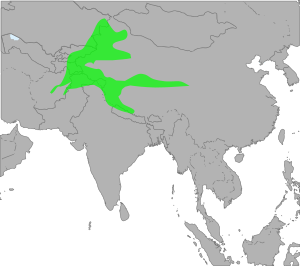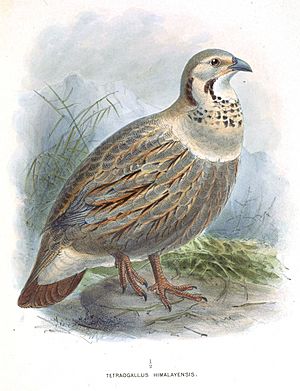Himalayan snowcock facts for kids
Quick facts for kids Himalayan snowcock |
|
|---|---|
 |
|
| Conservation status | |
| Scientific classification | |
| Genus: |
Tetraogallus
|
| Species: |
himalayensis
|
 |
|
The Himalayan snowcock (Tetraogallus himalayensis) is a large bird that looks a bit like a partridge. It belongs to the pheasant family. You can find these birds in the high Himalayas and parts of the Pamir Mountains in Asia. They live in grassy mountain areas and on steep, rocky cliffs. If they feel threatened, they will quickly fly down the hillsides to get away.
Sometimes, the Himalayan snowcock lives in the same areas as the slightly smaller Tibetan snowcock. Snowcocks from different places can look a little different in color. Scientists have named about five main types, called subspecies. In the 1960s, some Himalayan snowcocks were brought to the Ruby Mountains in Nevada, United States. Now, a wild group of these birds lives there.
Contents
What They Look Like
The Himalayan snowcock is a big bird, like a large grey partridge. It is about 55 to 74 centimeters (22 to 29 inches) long. It weighs between 2 and 3.1 kilograms (4.4 to 6.8 pounds).
Its head looks a bit like the smaller chukar partridge. It has a white throat and white sides on its head. These white areas are outlined by a reddish-brown stripe near its beak, like a mustache. A wide, dark reddish-brown band goes from its eye, over its ear, and around its neck.
The top part of its body is grey. The feathers on its back and wings have reddish-brown edges. Its upper chest is grey with dark, curved stripes. The lower chest is dark grey, and the sides of its body have black, reddish-brown, and white streaks. The feathers under its tail are white. Its legs and the skin around its eyes are yellow.
Male and female snowcocks look similar. However, the female is smaller. She also does not have the large spur (a sharp growth) on her leg that the male has. When the bird flies, you can see its white main wing feathers with black tips. Its outer tail feathers are reddish-brown, which helps you tell it apart. The Tibetan snowcock has a different wing pattern, with a white edge on its secondary feathers that stands out against its grey wings.
Types of Himalayan Snowcocks
Scientists have studied Himalayan snowcocks for a long time. In 1841, a bird was brought to London. It was later identified as a Himalayan snowcock.
The different groups of these birds are separated by the Taklamakan Desert. Scientists believe they became separate groups after the ice ages, about one million years ago. Because they live in many different places, these groups look a bit different. These different-looking groups are called subspecies. Here are some of the main subspecies:
- The first type, called the nominate subspecies, was described by Carl Linnaeus in 1758. It lives in eastern Afghanistan, Ladakh, and the central Himalayas of Nepal.
- incognitus was described in 1911. These birds live in southern Tadjikistan and northern Afghanistan. They are paler overall, with lighter reddish-brown and black marks on their underside.
- sewerzowi was described in 1910. It lives from Tien Shan to Zaysan in Kazakhstan, extending east to Xinjiang.
- grombczewskii was described in 1898. It lives in the Kunlun Mountains.
- koslowi was described in 1898. It lives in the Nan Shan and Ching Hai Ku Mountains of Qinghai and southern Gansu.
Where They Live and Their Status
Himalayan snowcocks live in high mountain areas of Central and South Asia. They prefer alpine pastures and steep mountain ridges above the treeline, close to the snowline. In the Himalayas, they are found between 4,000 and 5,000 meters (13,000 and 16,400 feet) high in summer. During harsh winters, they move down to about 2,400 meters (7,900 feet).
The Himalayan snowcock lives across a very large area. Its population does not seem to be decreasing. Because of this, the IUCN (International Union for Conservation of Nature) lists it as a species of "least concern." This means it is not currently in danger of extinction.
In 1961, people noticed that the mountains in Nevada looked similar to the Himalayas. The Nevada Fish and Game Commission thought the Himalayan snowcock would be a good bird to bring to the area for hunting. They asked the President of Pakistan for some birds. The first birds caught in the wild had trouble surviving the journey. So, birds were then raised locally at a game farm. Over 15 years (from 1965 to 1979), more than 2,000 birds were released into the wild. Now, a wild population of 200 to 500 birds lives in the Ruby Mountains. They look for food above the treeline.
Behaviour and Ecology
When they are not breeding, Himalayan snowcocks like to live in small groups. Several groups might even live on the same hill. They stay in open areas and seem to like rocky hillsides. They eat grass, young plant shoots, berries, and seeds. In the mornings, these birds fly downhill to drink water.
If someone approaches them from below, they try to climb up the slopes on foot. But if someone approaches from above, they will dive down into the valleys with their wings open to escape.
Reproduction and Life Cycle
In India, the breeding season for Himalayan snowcocks is in summer, from April to June. They are quiet in winter. But in spring, their calls are a common sound in the mountains. Their song is a loud, three-part whistle that gets higher in tone. They also make a rising, sharp piping call.
When they are eating, they walk slowly uphill. They pick up tender blades of grass and young shoots. They have been seen eating berries from Ephedra plants, leaves of Artemisia, grass shoots, bulbs, and the tops of a grass that looks like rye. In the Hunza area, they seem to prefer Sibbaldia cuneata.
Once they reach the top of a hill, they fly to another nearby hill. They land some distance down and then start walking uphill again. When they walk, they cock their tails, showing their white undertail feathers. They are usually very careful. If something disturbs them, they run uphill and then fly off from the top, gaining a lot of speed.
Living in groups helps them stay safe from predators. More eyes can watch out for danger, which lets them find food better. In rocky areas, where golden eagles might attack, their groups tend to be larger than in grassy meadows.
During courtship, the male bird crouches low to the ground. His wings are slightly spread, his tail is down, and his feathers are a bit ruffled. Then, he runs back and forth in front of the female or in circles.
The nest is just a bare scrape on the ground. It is usually hidden under a stone or a bush. They prefer to build nests close to the top of a ridge, on the side that is protected from the wind. The female lays about 5 to 12 long, oval eggs. These eggs are a stony olive or brown color and have red or brown spots. Only the female bird incubates the eggs.
The male stays with one female. He often sits on a high rock near the nest, watching out for anything that might bother them. If something disturbs him, he warns the female with a loud whistle. If the female is on the nest and surprised, she will not leave until someone gets very close. In an incubator, the eggs hatched after about 27–28 days.
Adult snowcocks are sometimes hunted by golden eagles.
Images for kids
See also
 In Spanish: Perdigallo himalayo para niños
In Spanish: Perdigallo himalayo para niños







